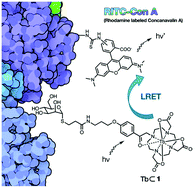A highly sensitive luminescent lectin sensor based on an α-d-mannose substituted Tb3+ antenna complex†
Abstract
Lectin–

Maintenance work is planned for Wednesday 1st May 2024 from 9:00am to 11:00am (BST).
During this time, the performance of our website may be affected - searches may run slowly and some pages may be temporarily unavailable. If this happens, please try refreshing your web browser or try waiting two to three minutes before trying again.
We apologise for any inconvenience this might cause and thank you for your patience.
* Corresponding authors
a
Department of Chemistry and Biochemistry and Centre for Research in NanoScience of Concordia University, 7141 Sherbrooke Street West, Montreal, QC H4B 1R6, Canada
E-mail:
capo@vax2.concordia.ca
Fax: (+) 1-515-848-2868
Tel: (+) 1-514-848-2424
b Istituto di Scienze e Tecnologie Molecolari (ISTM) of Consiglio Nazionale delle Ricerche (CNR), Via Golgi 19, I-20133 Milano, Italy
c
Polo Scientifico Tecnologico (PST) – CNR, Via Fantoli 16/15, I-20138 Milano, Italy
E-mail:
silvio.quici@istm.cnr.it
Fax: (+) 0039 02 503 14159
Tel: (+) 0039 02 503 14164
Lectin–

 Please wait while we load your content...
Something went wrong. Try again?
Please wait while we load your content...
Something went wrong. Try again?
E. Martín Rodríguez, N. Bogdan, J. A. Capobianco, S. Orlandi, M. Cavazzini, C. Scalera and S. Quici, Dalton Trans., 2013, 42, 9453 DOI: 10.1039/C3DT33023K
To request permission to reproduce material from this article, please go to the Copyright Clearance Center request page.
If you are an author contributing to an RSC publication, you do not need to request permission provided correct acknowledgement is given.
If you are the author of this article, you do not need to request permission to reproduce figures and diagrams provided correct acknowledgement is given. If you want to reproduce the whole article in a third-party publication (excluding your thesis/dissertation for which permission is not required) please go to the Copyright Clearance Center request page.
Read more about how to correctly acknowledge RSC content.
 Fetching data from CrossRef.
Fetching data from CrossRef.
This may take some time to load.
Loading related content
